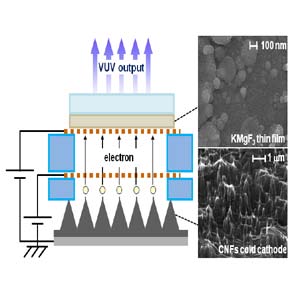This is within the range of vacuum-UV light -- so named because while light of that energy can propagate in a vacuum, it is quickly absorbed by oxygen in the air.
This fact makes vacuum UV light extremely useful for industrial applications from sterilizing medical devices to cleaning semiconductor substrates because when it strikes oxygen-containing molecules on a surface, it generates highly reactive oxygen radicals, which can completely destroy any microbes contaminating that surface.
Existing commercial vacuum UV lamps are bulky and expensive, however. They also use a lot of power, run hot, have short lifetimes and contain toxic gasses that can pollute the environment and harm people. The new lamp avoids those issues because it was fabricated with a solid-state phosphor made from a thin film of KMgF3, which is easy to make, avoids the use of toxic gasses and does not require expensive rare earth elements.
lamp is a promising light source in terms of lifetime, size, heat conduction and stability," said expert Shingo Ono. "[It] has the potential to be an excellent alternate light source to low-pressure mercury lamps, excimer lamps and deuterium lamps."

















Related Items
As China rises, Ukraine’s critical raw materials will be vital for West
Revival of Light and Sound Show at Agra Fort soon
How API technology can transform energy and carbon management